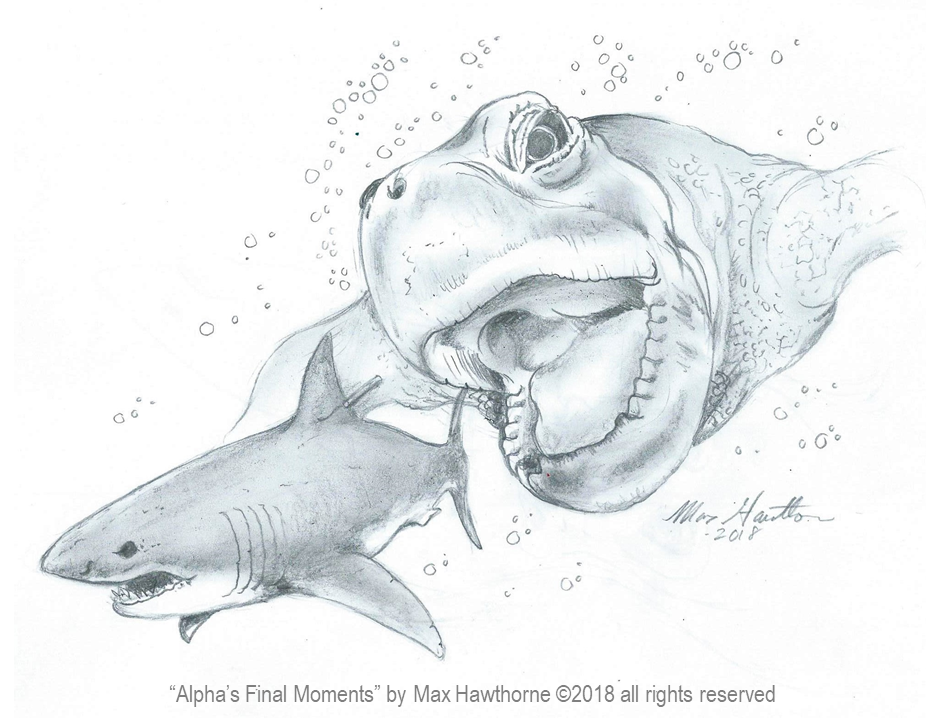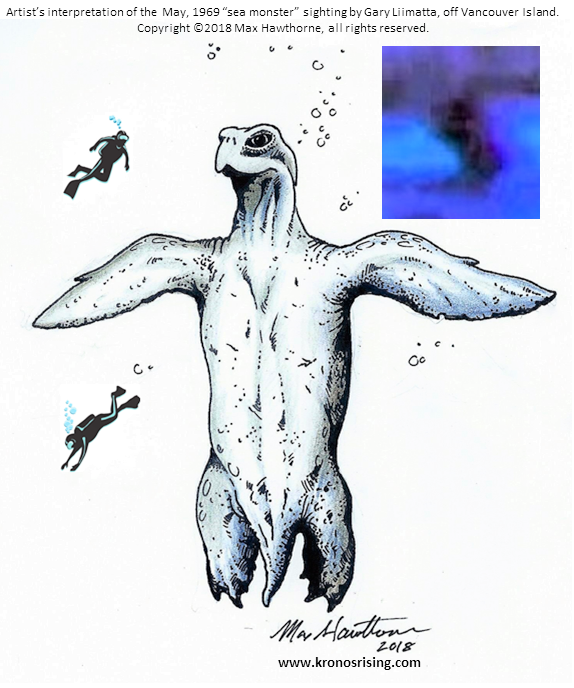It may soon be time for the mighty saltwater crocodile, Crocodylus porosus, to relinquish its title as the world’s largest living reptile. But to whom? Who is this challenger, this “pretender” to the saltie’s throne? Strangely enough, according to the growing evidence, a species of gigantic sea turtle which, if its existence ends up being formally documented, may also prove to be the “ Super Predator ” – the mysterious beast that, over a decade ago, preyed on a 3-meter great white shark off Australia’s infamous predator hot spot, the Bremer canyon.*
*For anyone interested in listening to my Blog Talk Radio show Max Hawthorne’s Marine Mysteries, where we discussed the identity of this creature at length, simply click here
Story Behind Super Predator
The story behind the devouring of the white shark known as “Alpha” by an unidentified marine predator is well-known and was covered in detail a few years back by not one, but two hour-long documentaries. Hunt For The Super Predator
The story is shocking. A 3-meter female (9+ feet) great white ended up being swallowed whole by an unknown carnivore. This was verified by a satellite tag attached to Alpha, which tracked her movements. Her swim patterns were normal until, one day, she (and the tag) suddenly plummeted almost 2,000 feet into the blackness of the Bremer canyon.
A moment later, the shark’s progress stopped and the temperature the tag was registering jumped from 46 degrees Fahrenheit (the temperature of the surrounding seawater) to 78 degrees (the body temperature of whatever consumed the tag and, presumably, Alpha. The temperature remained at 78 degrees, in the predator’s digestive tract, for the next 8 days, until the tag (which showed signs of being exposed to stomach acid) was excreted and eventually washed ashore.
The identity of this mysterious shark slayer remains unconfirmed, although numerous theories have been put forward. Whatever it was, it had to be huge and fast, and capable of diving to great depths without suffering ill effects.
Based on the two aforementioned documentaries, we’ve been able to glean some additional details about the attack. As I said, we already know that the Super Predator had an internal body temperature of 78 degrees Fahrenheit. We also know that it was capable of chasing down a 9+foot great white, that it could catch and kill it in the dark, that it was an air breather (the tag’s movements after the attack indicate an animal that remained at depths ranging from the surface to around 300 feet for the next 8 days – behavior similar to the movements of the air-breathing killer whale), and that it had a long and slow digestive system (it took 8 days for the tag to be excreted).
If you’re a follower of the Kronos Rising website, or if you’re one of the series followers New Release: Kronos Rising: Kraken vol. 2, you know that I explored the whole Super Predator topic in a 2017 post, and that I discussed why the “usual suspects” (a larger, cannibalistic great white, sperm and killer whales, and cephalopods) could not have been Alpha’s killer. Nothing totally matched with them – not their movements, abilities, speed, body temperature, or digestive systems. For details, see here: The Super Predator – It’s Not What They Say
Instead of rehashing this material, I’m going to focus on a few points that have been neglected and then focus on what, IMHO, the evidence indicates has to be the culprit. And for the record, it appears to be an undocumented and immense chelonian (turtle).
Abyssal Megalodon Theory
First, let’s discuss the “Abyssal Megalodon” theory. One of the two documentaries theorized suggested that there is a strain of Megalodon shark living in the ocean abysses, and that one of these behemoths swam up, killed Alpha, and then returned with its victim to its home in the deep. An entertaining tale, but the concept is a bit of a stretch. Even if a pelagic hunter like Megalodon did somehow adapt to live in the abyss, the facts don’t support one of them rising to the surface to kill Alpha.
Most of the prevailing theories imply that Alpha was seized by the Super Predator near the surface, dragged down almost 2,000 feet into the depths, and then devoured. This is wrong. The evidence indicates that Alpha was initially attacked high up in the water column, and that she dove deep in an effort to lose her attacker. Note: This is a documented technique that great whites use when fleeing killer whales, and if she knew her enemy was an air breather, it makes sense she would have tried the same thing to escape it. But how do we know Alpha did this? By studying the satellite tracking tags movements. If you look at this screenshot of a frame from one of the two documentaries, we see some interesting things.
A: This is the tag tracking Alpha’s movements before she was eaten. At the bottom of this track, the tag’s temperature jumps 32 degrees (from 46 to 78 degrees Fahrenheit)
B: This cluster of data indicates the tag’s movements after Alpha was ingested. This period is, according to the documentary, 8 days in length, and shows movements ranging from the surface to around 300 feet of water (indicating an air-breathing animal).
C: Although, to the best of my knowledge, this has not been discussed, this data cluster most likely represents after the tag was excreted, and before it was retrieved. It would have drifted along the bottom, until it eventually washed ashore with the tide.
D: An additional deep dive of Alpha’s. This one was made an estimated 3-4 days prior to her death and is a powerful indicator that she was attacked and pursued by something (most likely the same predator) and was able to escape it by diving into the depths.
E: Additional deep dives on Alpha’s part. Again, the evidence suggests the shark was attacked and pursued by something, and that she resorted to using the same instinctive technique to escape her pursuer.
Unanswered Question
One question that remains unanswered:
Why would Alpha be targeted repeatedly by the Super Predator?
Logically because, as stated in one of the documentaries, she was an aggressive and extremely confident shark, hence her name “Alpha”. It is likely that, if her attacker is what the evidence strongly suggests it to be, she failed to recognize it as a threat, interpreting it as being small and harmless at a distance, perhaps even potential prey, and allowed it to get close enough to make a run at her. It failed the first few times, but eventually succeeded.
The tracking data overwhelmingly suggests that shark Alpha was NOT seized and dragged to the bottom, but rather was pursued and caught nearly 2,000 feet down. Moreover, is also implies that she was not eaten by a Megalodon shark, or any other predator, living and hiding out in the ocean abysses. If Alpha’s killer was something that lived thousands of feet down and came up periodically to hunt (ignoring facts like speed, body temperature, and a digestive system that don’t match), why would it loiter around the surface for the next 8 days, acting like an air-breather? It wouldn’t have, and if it did it would have been seen. Logic dictates that it would have returned to its regular abode in the abyss, yet obviously it didn’t.
No. Whatever killed Alpha encountered her high in the water column – from the tag data, I’m estimating at around the 600-foot mark – and chased her down into the deep. It didn’t catch her and then drag her down to eat. If it had, it would have obviously remained there. Instead, it chased her down and caught her in the dark and consumed her there. Then, it returned to the surface (as its need for oxygen required it to) and remained there, satiated, as it digested its meal.
My Theory on This Super Predator
In my previous article, I stated that whatever the Super Predator was, it had to be some sort of undocumented marine reptile. We know now that, based on available research on mosasaur and plesiosaur body temperatures, that those animals are not a match. Their body temps were too hot – mammalian levels or higher. Which leads us back to the only suspect that, temperature-wise, matches – the leatherback sea turtle.
Of course, we know that leatherbacks aren’t chasing and eating sharks as big or bigger than them. But, except for the size issue, they do have all the necessary tools for the job. They can swim extremely fast (22 mph, and a giant version that evolved to prey on large fish would be even faster) and can dive to depths of at least 4,200 feet. The Leatherback Sea Turtle They can also stay submerged for over an hour if need be. And, even more interestingly, their digestive systems are extremely complex – six times longer than that of other sea turtles.
If one had evolved to consume fish, it would come as no surprise that it would take a week or more to finish the job (fast forward to around 23 minutes) Inside the Leatherback Sea Turtle Lastly, and as previously covered in detail, leatherbacks have a body temperature that is substantially higher than that of the surrounding water – up to 32 degrees higher. And THAT, dear reader, is exactly the temp difference between the Super Predator’s stomach and that of the surrounding sea. Interesting, don’t you think?
All of this adds up to a very convincing argument.
The speed, diving ability, respiration, body temperature and even digestive system of the Super Predator all seem to indicate an animal just like a leatherback sea turtle. However, leatherbacks, even at their maximum size of 1,500+ lbs. (some reports put them at over 2,000) is incapable of killing, let alone devouring a 10-foot, 600 lb. shark (rough guess).
Not to mention,
they eat jellyfish. But evidence DOES exist that strongly suggests there is a much larger species of sea turtle out there. A turtle similar to the leatherback in that it has no shell, but that is leaner, faster, and much, much bigger.
I’m referring to the turtle that was both seen and filmed back in 1969 by fisherman Garry Liimatta, from his boat. He described it as being 38’ long and capable of “terrific speed”. For full details on the sighting, including my investigation and enhancements of frames from his old Super-8 footage, which convinced me that his description of his sighting was spot-on, go to: https://kronosrising.com/the-garry-liimatta-sea-monster-have-we-identified-this-mysterious-creature/
I would also point out that Garry’s sighting is not the first of its kind; there are other anecdotal reports that suggest that a turtle of this size and description exists. For example, the ‘Soay beast’ of Scotland was spotted in 1959 off the Scottish island of Soay. The two witnesses, Tex Geddes and ‘James Gavin’, watched the animal from a small fishing. Geddes’s version of the sighting appeared in a local newspaper:
“I noticed a large black shape on the surface of the water … probably two miles from where we were fishing. When the object appeared to be steaming towards us we both stood up for a better view. We both stared in amazement … for this beast … was like some hellish monster of prehistoric times. The head was definitely reptilian 2 ft. 6 ins high, with large protruding eyes. There were no visible nasal organs, but a large red gash of a mouth which seemed to cut the head in half and which appeared to have distinct lips. The creature’s back which rose sharply to its highest point some three or four feet out of the water, fell away gradually towards the after end. I would say that we saw eight to ten feet of back on the waterline. Petrified we stood and watched as it came closer and closer. It was soon up parallel with the dinghy at a distance of twenty yards. It seemed oblivious to our presence despite the fact that it was constantly turning its head from side to side, as if surveying all around it.”
This animal sounds remarkably similar, both in terms of size and behavior, to Liimatta’s huge, shell-less turtle.
In 1877, the royal yacht Osborne, while docked in Gibraltar, encountered a similar, albeit even larger, turtle. One of the witnesses, a Lieutenant William Haynes, reported: “I distinctly saw a head, two flappers, and about thirty feet of an animal’s shoulder. The head, as nearly as I could judge, was about six feet thick, the neck narrower, about four to five feet, the shoulder about fifteen feet across, and the flappers each about fifteen feet in length. The movements of the flappers were those of a turtle, and the animal resembled a huge seal, the resemblance being strongest about the back of the head. I could not see the length of the head, but from its crown or top to just below the shoulder (where it became immersed), I should reckon about fifty feet. The tail end I did not see, being under water.”
Granted, these are both anecdotal reports without hard evidence, but when combined with Liimatta’s footage, however old and grainy, it becomes likely that some sort of oversized sea turtle is out there, waiting to be found. At a length of around 40 feet (the size of a gray whale), such an animal would definitely be able to chase down and consume a 3-meter great white, as easily as a big loggerhead could a two-foot-long dogfish. My drawing from the earlier blog post shows how big Garry’s turtle would be compared to a pair of 6-foot divers.
If such an animal exists – one with a longer-than-normal neck, and little fear of humans – it is most likely a piscivore (fish eater) or omnivore, like the loggerhead, and subsists on a diet of fish, jellyfish, and large aquatic plants. It would, based on its size, per force, give birth to live young, in the manner of extinct mosasaurs and pliosaurs. It would have the speed to catch a sub-adult great white (30+ mph in bursts), the ability to handle extreme pressure (as does the leatherback), be able to see in the dark with its large eyes, have a body temperature in the range of the Super Predator (32 degrees differential, again, per the leatherback) and have an extremely long and slow digestive system that would account for taking 8 days to finish its meal.
Conclusion
One final piece to the puzzle that helps to cinch things; during one of the documentaries, it was reported that one of the research vessels in the area had a sonar reading that seemed to match the predator they were looking for. This anomalous reading indicated a creature 10.5 meters long (around 35 feet) and swimming slowly.
Now, leatherbacks may exceed 20 mph when pressed, but I think it’s common knowledge that, when moving from place to place, they’re generally slow. So, once again, this sonar reading does, indeed, match the profile of a giant turtle, similar to that from the Liimatta sighting.
Put all of that together, and the evidence implies that we have a large and undocumented marine reptile roaming our oceans – something whose ancestors most likely survived the Cretaceous extinction and grew and evolved over time. In honor of the late Garry Liimatta, who managed to garner the first footage of this elusive animal, I propose that, when concrete proof of its existence is finally gathered, it is assigned the scientific name Titanichelys liimatti (Liimatta’s titanic turtle). I’ve also drafted a sketch of what I believe human visitors in a passing submarine might have seen, as the turtle in question closed on poor doomed Alpha.
Ladies and gentlemen . . . I leave it to you to decide. Is this the SUPER PREDATOR?

Thanks very much, and I hope you enjoyed the post. Feel free to submit comments to the site’s moderators, and if you haven’t picked up a copy of Kronos Rising: Kraken vol. 2, be sure to check it out on Amazon. KRONOS RISING: KRAKEN vol. 2 Amazon link
Also, thanks to cryptozoologist Scott Mardis for the leatherback sea turtle anatomy video link.
Best,
Max Hawthorne
#princeofpaleofiction
#JawsMeetsJurassicPark



